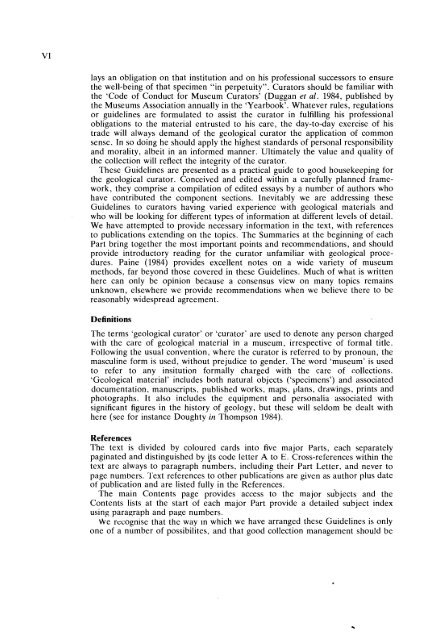GUIDELINES FOR THE CURATION OF GEOLOGICAL MATERIALS
GUIDELINES FOR THE CURATION OF GEOLOGICAL MATERIALS
GUIDELINES FOR THE CURATION OF GEOLOGICAL MATERIALS
You also want an ePaper? Increase the reach of your titles
YUMPU automatically turns print PDFs into web optimized ePapers that Google loves.
lays an obligation on that institution and on his professional successors to ensure<br />
the well-being of that specimen "in perpetuity". Curators should be familiar with<br />
the 'Code of Conduct for Museum Curators' (Duggan et al. 1983, published by<br />
the Museums Association annually in the 'Yearbook'. Whatever rules, regulations<br />
or guidelines are formulated to assist the curator in fulfilling his professional<br />
obligations to the material entrusted to his care, the day-to-day exercise of his<br />
trade will always demand of the geological curator the application of common<br />
sense. In so doing he should apply the highest standards of personal responsibility<br />
and morality, albeit in an informed manner. Ultimately the value and quality of<br />
the collection will reflect the integrity of the curator.<br />
These Guidelines are presented as a practical guide to good housekeeping for<br />
the geological curator. Conceived and edited within a carefully planned framework,<br />
they comprise a compilation of edited essays by a number of authors who<br />
have contributed the component sections. Inevitably we are addressing these<br />
Guidelines to curators having varied experience with geological materials and<br />
who will be looking for different types of information at different levels of detail.<br />
We have attempted to provide necessary information in the text, with references<br />
to publications extending on the topics. The Summaries at the beginning of each<br />
Part bring together the most important points and recommendations, and should<br />
provide introductory reading for the curator unfamiliar with geological procedures.<br />
Paine (1984) provides excellent notes on a wide variety of museum<br />
methods, far beyond those covered in these Guidelines. Much of what is written<br />
here can only be opinion because a consensus view on many topics remains<br />
unknown, elsewhere we provide recommendations when we believe there to be<br />
reasonably widespread agreement.<br />
Definitions<br />
The terms 'geological curator' or 'curator' are used to denote any person charged<br />
with the care of geological material in a museum, irrespective of formal title.<br />
Following the usual convention, where the curator is referred to by pronoun, the<br />
masculine form is used, without prejudice to gender. The word 'museum' is used<br />
to refer to any insitution formally charged with the care of collections.<br />
'Geological material' includes both natural objects ('specimens') and associated<br />
documentation, manuscripts, published works, maps, plans, drawings, prints and<br />
photographs. It also includes the equipment and personalia associated with<br />
significant figures in the history of geology, but these will seldom be dealt with<br />
here (see for instance Doughty in Thompson 1984).<br />
References<br />
The text is divided by coloured cards into five major Parts, each separately<br />
paginated and distinguished by !ts code letter A to E. Cross-references within the<br />
text are always to paragraph numbers. including their Part Letter, and never to<br />
page numbers. Text references to other publications are given as author plus date<br />
of publication and are listed fully in the References.<br />
The main Contents page provides access to the major subjects and the<br />
Contents lists at the start of each major Part provide a detailed subject index<br />
using paragraph and page numbers.<br />
We recognise that the way In which we have arranged these Guidelines is only<br />
one of a number of possibilites, and that good collection management should be

















